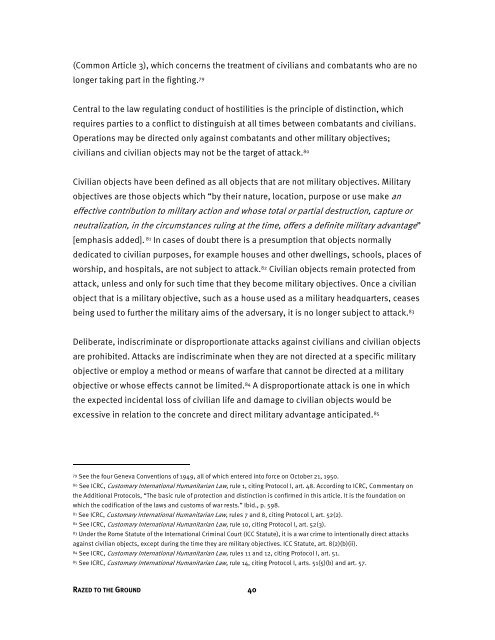Download the full report - Human Rights Watch
Download the full report - Human Rights Watch
Download the full report - Human Rights Watch
You also want an ePaper? Increase the reach of your titles
YUMPU automatically turns print PDFs into web optimized ePapers that Google loves.
(Common Article 3), which concerns <strong>the</strong> treatment of civilians and combatants who are no<br />
longer taking part in <strong>the</strong> fighting. 79<br />
Central to <strong>the</strong> law regulating conduct of hostilities is <strong>the</strong> principle of distinction, which<br />
requires parties to a conflict to distinguish at all times between combatants and civilians.<br />
Operations may be directed only against combatants and o<strong>the</strong>r military objectives;<br />
civilians and civilian objects may not be <strong>the</strong> target of attack. 80<br />
Civilian objects have been defined as all objects that are not military objectives. Military<br />
objectives are those objects which “by <strong>the</strong>ir nature, location, purpose or use make an<br />
effective contribution to military action and whose total or partial destruction, capture or<br />
neutralization, in <strong>the</strong> circumstances ruling at <strong>the</strong> time, offers a definite military advantage”<br />
[emphasis added]. 81 In cases of doubt <strong>the</strong>re is a presumption that objects normally<br />
dedicated to civilian purposes, for example houses and o<strong>the</strong>r dwellings, schools, places of<br />
worship, and hospitals, are not subject to attack. 82 Civilian objects remain protected from<br />
attack, unless and only for such time that <strong>the</strong>y become military objectives. Once a civilian<br />
object that is a military objective, such as a house used as a military headquarters, ceases<br />
being used to fur<strong>the</strong>r <strong>the</strong> military aims of <strong>the</strong> adversary, it is no longer subject to attack. 83<br />
Deliberate, indiscriminate or disproportionate attacks against civilians and civilian objects<br />
are prohibited. Attacks are indiscriminate when <strong>the</strong>y are not directed at a specific military<br />
objective or employ a method or means of warfare that cannot be directed at a military<br />
objective or whose effects cannot be limited. 84 A disproportionate attack is one in which<br />
<strong>the</strong> expected incidental loss of civilian life and damage to civilian objects would be<br />
excessive in relation to <strong>the</strong> concrete and direct military advantage anticipated. 85<br />
79 See <strong>the</strong> four Geneva Conventions of 1949, all of which entered into force on October 21, 1950.<br />
80 See ICRC, Customary International <strong>Human</strong>itarian Law, rule 1, citing Protocol I, art. 48. According to ICRC, Commentary on<br />
<strong>the</strong> Additional Protocols, “The basic rule of protection and distinction is confirmed in this article. It is <strong>the</strong> foundation on<br />
which <strong>the</strong> codification of <strong>the</strong> laws and customs of war rests.” Ibid., p. 598.<br />
81 See ICRC, Customary International <strong>Human</strong>itarian Law, rules 7 and 8, citing Protocol I, art. 52(2).<br />
82 See ICRC, Customary International <strong>Human</strong>itarian Law, rule 10, citing Protocol I, art. 52(3).<br />
83 Under <strong>the</strong> Rome Statute of <strong>the</strong> International Criminal Court (ICC Statute), it is a war crime to intentionally direct attacks<br />
against civilian objects, except during <strong>the</strong> time <strong>the</strong>y are military objectives. ICC Statute, art. 8(2)(b)(ii).<br />
84 See ICRC, Customary International <strong>Human</strong>itarian Law, rules 11 and 12, citing Protocol I, art. 51.<br />
85 See ICRC, Customary International <strong>Human</strong>itarian Law, rule 14, citing Protocol I, arts. 51(5)(b) and art. 57.<br />
RAZED TO THE GROUND 40
















